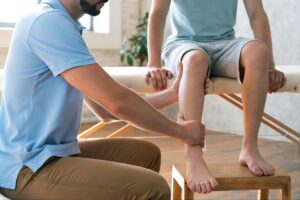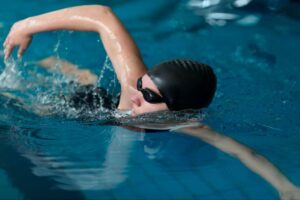Case study: the always on 13 year old
Ishaan, 13, plays academy football five evenings a week, cricket on weekends, and squeezes in a swim before school. Two months into this schedule he develops heel pain that is worst after practice, knee pain on stairs, and restless sleep with low mood.
At VARDĀN, assessment shows a classic young athlete pattern: a rapid spike in weekly load, tight calves during a growth spurt, and weak hip control. A short block of Functional Manual Therapy to free ankle and hip motion, age appropriate strength and balance work, and a sane weekly plan with two rest days helps Ishaan return to sport comfortably without the boom and bust cycle.
Introduction: Why Youth Sports Injuries Deserve Attention
Youth athletes are playing more sports, training harder, and specializing earlier than ever before. While sports build strength, confidence, and teamwork, they also increase the risk of overuse and acute injuries at a young age.
Coaches and parents are the first line of defense. Understanding how injuries happen, what signs to watch for, and how to prevent them is critical for protecting young athletes’ long-term health.
Anatomy of Young Athletes: Why They’re Different
- Growth Plates (Epiphyseal Plates): Soft areas at the ends of long bones are weaker and prone to injury.
- Muscle–Tendon Imbalance: During growth spurts, bones may lengthen faster than muscles and tendons adapt → tightness, reduced flexibility.
- Developing Coordination: Motor skills and balance are still improving, which can lead to faulty movement patterns.

Age-Wise Sports Injuries in Youth Athletes
| Age Group | Common Injuries | Why They Happen | Prevention Focus |
|---|---|---|---|
| 6–9 years (Early Childhood) | Minor sprains, bruises, falls | Coordination still developing, weaker balance | Focus on fun, skill development, safe environment. Keep sessions short and playful. |
| 10–12 years (Pre-Teens) | Overuse injuries (heel pain – Sever’s disease, knee pain – Osgood-Schlatter), minor sprains | Growth spurts → muscles/tendons lag behind bone growth | Teach basic warm-ups, stretching, proper footwear. Avoid excessive repetitive drills. |
| 13–15 years (Early Teens) | Stress fractures, knee/ankle sprains, shoulder/elbow pain (throwing/swimming) | Rapid growth + higher training loads; hormonal changes affect tissue strength | Load management, cross-training, age-appropriate strength training. Educate about recovery and rest days. |
| 16–18 years (Late Teens) | ACL tears, rotator cuff strains, chronic back pain, concussions (contact sports) | High intensity, year-round competition, early specialization | Emphasize sport-specific conditioning, injury screening, proper technique, FMT/manual therapy when needed. Encourage multi-sport participation. |
Why youth athletes get hurt more easily
- Growing tissues: Open growth plates and tendon attachment sites are sensitive to repeated load.
- Load spikes: Sudden jumps in practice time, tournament clusters, or adding a second team raise risk.
- Early specialization: Playing one sport all year stresses the same tissues the same way.
- Technique and equipment: Rapid height changes outpace skill, and poorly fitted shoes or racquets multiply stress.
- Recovery debt: Too little sleep, hydration, and fuel slow adaptation.
How Functional Manual Therapy helps young athletes stay healthy
- Clear restrictions Gentle manual techniques restore easy ankle, hip, and mid back motion so movement feels natural, not forced.
- Rewire coordination Core first strategies, shoulder blade mechanics, and hip to trunk timing let force flow through the chain instead of into one joint.
- Build age appropriate capacity Short, focused strength, balance, and endurance sessions that match growth stage and sport demands.
- One plan for child, coach, and parent A simple progression that everyone understands: daily comfort to controlled drills to full practice to match play, with weekly check ins.

The youth injuries you will see and what to do first
Fast guide for coaches and parents
| Age band | Common hot spots | Red flags to act on now | Do this | Avoid this |
|---|---|---|---|---|
| 8 to 11 years | Heel Sever’s, wrist growth plates, early shoulder irritation | Night pain, limping, visible swelling | Teach skills with variety, 1 to 2 rest days each week, basic balance and bodyweight drills | Playing one sport all year, marathon tournaments |
| 12 to 14 years growth spurt | Knee Osgood Schlatter, hip flexor strains, back tightness | Sudden performance drop, persistent morning pain | Track weekly minutes, progress volume before intensity, check footwear | Adding extra teams while growing fast |
| 15 to 17 years | Patellar tendon, hamstring, ACL risk in cutting sports | A pop with swelling, instability, repeated giving way | Structured strength, landing mechanics, sprint mechanics, 2 to 3 months off each year from any one sport not necessarily consecutive | Stacking matches without recovery, chasing personal bests during exams |
Your practical weekly blueprint
- Rest: Plan 1 to 2 full days off organised training each week.
- Seasonality: Aim for 2 to 3 months off per year from any one sport and avoid more than 8 months per year in the same sport.
- Volume rule of thumb: Keep weekly organised sport hours at or below the child’s age.
- Progression: Increase total load gradually and use the next day feel test before advancing.
- Sleep and fuel: Prioritise 8 to 10 hours of sleep for teens and regular meals with enough protein and carbohydrate.
- Technique blocks: Short skill sessions when fresh beat long fatigued sessions.
Parent checklist
- Keep one calendar for school and sport. Flag exam weeks and taper practice then
- Audit shoes, racquet grip, and backpack weight every quarter.
- Watch mood, sleep, and enthusiasm. Persistent dips often precede injury.
- Celebrate process such as skills and consistency, not only medals and minutes played.

One minute home screen
- Wall reach: Both arms up. Any pinch or side to side difference
- Single leg balance: Twenty seconds each side. Does one hip drop
- Calf raise: Twenty smooth reps. Symmetry
- Hop and stick: Small hop, quiet landing. Do the knees cave in
Move smarter. Play longer. Enjoy sport.
Reset. Rebuild. Return.
Request an Appointment at VARDĀN, Lajpat Nagar, New Delhi for a personalised Functional Manual Therapy assessment and a sport specific rehab plan.
Call us today at +91 011 43580720-22 / 9810306730
📅 Book your root-cause consultation at www.vardan.in
📍 Visit our advanced physiotherapy clinic in Delhi in Lajpat Nagar




